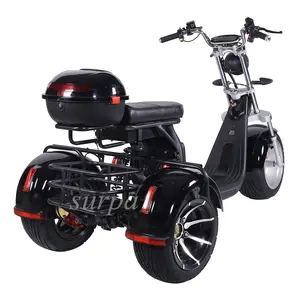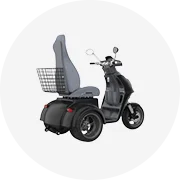Types of Goldwing Trikes
A Goldwing trike is a three-wheeled motorcycle variant that offers enhanced stability, comfort, and riding ease. These vehicles combine the excitement of motorcycle riding with the stability advantages of three-wheel design. Let's explore the different types available in today's market:
Conversion Kits
Standard Goldwing motorcycles that have been transformed into trikes using aftermarket conversion systems. These kits include:
- Rear axle assembly with custom suspension
- Detailed installation hardware
- Often includes fenders and bodywork
Benefit: Allows riders to convert their existing Goldwing into a stable trike while preserving the original motorcycle's performance characteristics.
Goldwing Roadsmith Trikes
Purpose-built three-wheeled motorcycles specifically designed as trikes from the ground up. Features include:
- Powerful engines optimized for trike performance
- Ergonomically designed comfortable seating
- Advanced technology integration (GPS, audio systems)
- Custom suspension tuned for three-wheel dynamics
Benefit: Superior integration of components creates a seamless riding experience specifically engineered for trike dynamics.
GL1800 and GL1500 Trikes
Popular Goldwing motorcycle models that serve as excellent platforms for trike conversion:
- GL1800: Features 1,800cc flat-six engine with advanced touring capabilities
- GL1500: Offers 1,520cc power plant with classic Goldwing reliability
- Both models accept various conversion systems
Benefit: Provides the reliability and performance of Honda's engineering with the added stability of trike configuration.
Expert Tip: When considering a Goldwing trike, examine both factory-built options and conversion kits. Factory-built trikes often have more integrated designs, while conversion kits can be more cost-effective if you already own a Goldwing motorcycle.
| Trike Type | Best For | Price Range | Key Features |
|---|---|---|---|
| Conversion Kits | Existing Goldwing owners | $7,000-$12,000 (kit only) | Cost-effective transformation, preserves original bike character |
| Roadsmith Trikes | Luxury touring enthusiasts | $30,000-$45,000 | Purpose-built design, premium comfort features |
| GL1800 Trikes | Performance-oriented riders | $25,000-$40,000 (converted) | Modern electronics, powerful engine, advanced handling |
| GL1500 Trikes | Value-conscious buyers | $15,000-$25,000 (converted) | Proven reliability, simpler maintenance, classic styling |
Specifications & Maintenance of Goldwing Trikes
Understanding the specifications and maintenance requirements of your Goldwing trike is essential for ensuring optimal performance, safety, and longevity. Below are the key systems that require regular attention:
Engine Specifications & Maintenance
- Oil Change: Every 6 months or 8,000 miles
- Cooling System: Check for leaks regularly, replace coolant every 3 years/36,000 miles
- Air Filter: Inspect every 12,000 miles, replace as needed
- Spark Plugs: Replace every 2 years/24,000 miles
- Valve Clearance: Check according to service manual specifications
- Timing Belt: Inspect for wear, replace per mileage interval
Chassis Components
- Frame: Clean regularly, inspect for cracks or damage
- Control Components: Adjust handlebars, footpegs, and gear shifters for comfort
- Wheel Bearings: Inspect and lubricate per maintenance schedule
- Tires: Check tread depth and wear patterns monthly
- Suspension: Adjust based on rider weight and preferences
- Brakes: Inspect pads and rotors every 6,000 miles
Electrical System
- Battery: Clean terminals monthly, replace every 3-5 years
- Lighting: Check functionality of all lights before each ride
- Audio System: Test and adjust for optimal sound quality
- Wiring: Inspect for wear, corrosion, or loose connections
- Charging System: Verify proper voltage output annually
Bodywork & Accessories
- Cleaning: Wash regularly with motorcycle-specific cleaners
- Body Parts: Inspect fenders and fairing for damage
- Windshield: Clean and check for cracks or chips
- Entertainment: Test radio, GPS, and heated grip functionality
- Storage: Maintain luggage components and mounting hardware
Important Maintenance Note: Goldwing trikes have unique maintenance requirements compared to standard motorcycles due to their differential and additional rear wheel components. The rear drive system requires specialized service intervals—typically differential fluid changes every 24,000 miles and drive shaft inspection every 12,000 miles.
How to Choose a Goldwing Trike
Selecting the perfect Goldwing trike requires careful consideration of several important factors. Your riding experience, intended use, and personal preferences will all play significant roles in determining the best choice for your needs.
Riding Experience Considerations
Match your trike to your skill level:
- Beginners: Look for models with reverse gear systems for easier maneuvering
- Intermediate: Consider models with adjustable suspension settings
- Advanced: Focus on performance-oriented options with responsive handling
Feature Requirements
Prioritize the options that matter most to you:
- Comfort: Heated seats, adjustable windshields, ergonomic controls
- Technology: Advanced audio systems, navigation, Bluetooth connectivity
- Storage: Integrated luggage compartments, trunk space capacity
- Passenger Accommodation: Comfortable rear seating, passenger controls
Intended Use Assessment
Different models excel at different riding styles:
- Long-Distance Touring: Larger fuel tanks, comfortable seating, wind protection
- City Commuting: More compact dimensions, responsive handling at lower speeds
- Group Riding: Communication systems, passenger comfort features
- Weekend Pleasure Rides: Balance of comfort and performance features
Selection Tip: When possible, test ride multiple Goldwing trike models to experience their handling characteristics firsthand. Pay particular attention to low-speed maneuverability, as this is where trikes differ significantly from two-wheeled motorcycles.
| Selection Factor | Considerations | Impact on Riding Experience |
|---|---|---|
| Budget | New vs. used, conversion vs. factory-built | Determines available features and quality level |
| Riding Style | Touring focus vs. sporty handling | Affects comfort on long rides vs. agility on curvy roads |
| Physical Considerations | Rider height, weight, physical limitations | Influences ergonomic comfort and control accessibility |
| Maintenance Ability | DIY vs. dealer service | More complex models may require professional maintenance |
| Storage Needs | Luggage capacity, compartment accessibility | Determines practicality for different trip lengths |
DIY Goldwing Trike Conversion & Replacement
Converting a standard Goldwing motorcycle to a trike configuration is a complex but rewarding project for mechanically inclined enthusiasts. Follow this step-by-step guide to successfully complete your conversion:
Warning: Trike conversion is a significant mechanical undertaking that affects vehicle safety and handling. If you're uncertain about any aspect of the process, consult with a professional mechanic or trike conversion specialist. Improper installation can lead to dangerous riding conditions.
Gather Tools and Materials
Essential equipment for conversion includes:
- Complete socket and wrench sets (metric and standard)
- Torque wrench (capable of accurate settings between 20-100 ft-lbs)
- Motorcycle lift or stable center stand
- Proper Goldwing rear axle conversion kit specific to your model
- Thread-locking compound and anti-seize lubricant
- Service manual for your specific Goldwing model
Prepare Your Workspace
Create an environment conducive to a successful conversion:
- Clean, well-lit area with sufficient space (minimum 10'×15')
- Level, solid floor surface
- Organize parts in labeled containers as you disassemble
- Keep a digital camera handy to document original configurations
Disconnect Electrical Components
Carefully manage the electrical system:
- Disconnect the negative battery terminal first
- Label all electrical connections before removal
- Document wire routing for taillight, turn signals, and ABS sensors
- Protect disconnected plugs from dirt and moisture
Remove Existing Rear Components
Systematically disassemble the rear section:
- Remove saddlebags, trunk, and rear bodywork
- Detach rear wheel, brake components, and suspension
- Preserve all hardware in labeled containers
- Take reference photos at each major step
Install Conversion Kit Framework
Follow manufacturer instructions precisely:
- Mount the main trike frame to the motorcycle frame
- Install all mounting brackets and support structures
- Use a torque wrench to ensure proper fastener tightness
- Apply thread-locking compound to critical fasteners
Install Rear Axle and Differential
Properly set up the drive system:
- Mount the differential unit according to kit instructions
- Connect the driveshaft from the transmission to the differential
- Fill the differential with the specified lubricant
- Check for proper alignment and smooth operation
Mount Wheels and Brakes
Ensure safety-critical components are properly installed:
- Install brake components according to kit specifications
- Mount wheels and tires with correct spacers and hardware
- Verify proper wheel alignment and tracking
- Torque lug nuts to specified values in a cross pattern
Reconnect and Route Electrical Systems
Carefully restore all electrical functionality:
- Route wiring harnesses according to kit instructions
- Connect brake lights, turn signals, and license plate illumination
- Install and connect any ABS sensors or electronic components
- Secure all wiring away from moving parts and heat sources
Install Bodywork and Final Components
Complete the visual and functional aspects:
- Mount fenders, bodywork, and trim components
- Install trunk and storage compartments
- Verify all lighting functions correctly
- Check for proper clearance between all components
Final Checks and Test Ride
Verify safety and performance:
- Double-check all fasteners for proper torque
- Verify tire pressures meet specifications
- Test all electrical systems and controls
- Begin with a slow test ride in a safe, controlled area
- Make any necessary adjustments to suspension and alignment
Pro Tip: Document your entire conversion process with photos and notes. This documentation will be invaluable for future maintenance and troubleshooting. Consider creating a maintenance log specific to your converted trike to track service intervals for new components.
Frequently Asked Questions
Goldwing trikes come from several sources in the motorcycle industry:
- Honda: Manufactures the original Goldwing motorcycles that serve as the foundation for most trikes
- Conversion Companies: Specialized manufacturers like Motor Trike, Lehman Trikes, and California Side Car produce conversion kits
- Roadsmith: Creates purpose-built Goldwing trike models with integrated designs
- Custom Builders: Independent shops that perform conversions using proprietary or third-party components
While Honda produces the base Goldwing motorcycles, most complete trikes are either conversions of existing motorcycles or specially built by aftermarket manufacturers using Honda powertrains and components.
Goldwing trikes offer numerous advantages over traditional motorcycles:
- Enhanced Stability: Three-wheel design eliminates the need to balance at stops and low speeds
- Increased Comfort: Advanced suspension systems and ergonomic seating reduce rider fatigue
- Greater Cargo Capacity: Expanded storage options for long-distance touring
- Accessibility: Easier for riders with physical limitations or those who find two-wheeled motorcycles challenging
- Passenger Comfort: More stable platform for carrying passengers, reducing their anxiety
- All-Season Riding: Better traction and control in adverse weather conditions
These benefits make Goldwing trikes particularly popular among older riders, those with physical limitations, and touring enthusiasts who prioritize comfort and stability.
Goldwing trikes are highly customizable vehicles that can be tailored to specific rider requirements:
- Comfort Modifications: Custom seats, adjustable handlebars, footrest positioning
- Technology Upgrades: Advanced GPS systems, premium audio equipment, communication devices
- Performance Enhancements: Engine tuning, exhaust systems, suspension adjustments
- Aesthetic Customization: Custom paint, chrome accessories, lighting packages
- Adaptive Equipment: Hand controls, automatic transmissions for riders with physical limitations
- Storage Solutions: Additional cargo compartments, trailer hitches, specialized racks
The aftermarket support for Goldwing trikes is extensive, allowing owners to create a truly personalized riding experience that addresses their specific needs and preferences.
Goldwing trikes excel at long-distance touring and are considered among the premier touring vehicles available:
- Exceptional Comfort: Plush seating, ergonomic controls, and wind protection reduce fatigue on extended rides
- Abundant Storage: Built-in compartments and expandable luggage options accommodate gear for extended trips
- Powerful Performance: Robust engines provide consistent power delivery for highway cruising and mountain passes
- Fuel Efficiency: Despite their size, many models offer impressive range between fill-ups
- Entertainment Features: Integrated audio systems, connectivity options, and navigation make long journeys more enjoyable
- Weather Protection: Substantial fairings and windshields provide better protection from elements than most motorcycles
The stability of three wheels combined with Goldwing's legendary comfort makes these trikes ideal for cross-country journeys, with many owners regularly undertaking trips of thousands of miles.






















































































































































































































 浙公网安备 33010002000092号
浙公网安备 33010002000092号 浙B2-20120091-4
浙B2-20120091-4